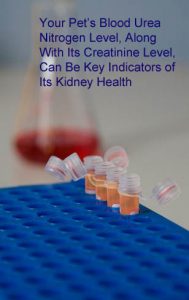Ron Hines DVM PhD
 See What Normal Blood & Urine Values Are
See What Normal Blood & Urine Values Are
 Causes Of Most Abnormal Blood & Urine Tests
Causes Of Most Abnormal Blood & Urine Tests
Your Pet’s BUN = Urea, Blood Urea Nitrogen
Urea is both an industrial chemical and a vital step in your cat or dog’s metabolism. The urea in your pet’s blood is formed in its liver from the excess ammonia that is left over when proteins are metabolized. Urea is a less toxic compound than ammonia. So, all mammals convert the nitrogen portion of ammonia into urea before it is transported through their bloodstream to its kidneys for elimination. Monitoring your dog and cat’s blood urea and blood creatinine levels from adulthood through old age is a fundamental kidney health indicator for veterinarians. Your physician will tell you that too.
When your veterinarian sees that your pet’s blood urea nitrogen/BUN and its creatinine levels are significantly elevated, your vet might just tell you that your dog or your cat is “azotemic” or “uremic” – two other terms that describe the same situation. However, the excessive amounts of urea and creatinine in these situations are only two of many unhealthy waste products that are accumulating. It just happens to be that these two can be measure easily.
Reasons Why Your Dog Or Cat’s BUN Might Be High:
There are many reasons that your pet’s BUN might be higher than normal. But most dogs and cats that have elevated BUN levels have it because their kidneys can no longer excrete urea in sufficient amounts. In those cases, it is called a “renal elevation”. Renal-elevated BUN occurs in cats and in dogs when about two thirds of their kidney’s filtering capacity has been lost. Until that point, your pet will probably appear normal and just compensate for its decreased kidney capacity by drinking and urinating more.
Much less commonly, dog and cat BUN levels rise due to things other than overt kidney damage. That is called a “pre-renal elevation”. Situations that allow large amounts of fluid to leak from your pet’s bloodstream are causes of pre-renal elevated BUN. That includes extensive burns, sustained bleeding, prolonged fever, vomiting or diarrhea and excessive heat exposure leading to dehydration. Diuretics also have the potential to cause dehydration that elevates your pet’s BUN. ACE inhibitors, given for heart problems occasionally restrict blood flow through the kidneys. NSAIDs given to control pain and arthritis occasionally raise BUN as well – probably also because they can reduce blood flow through the kidneys. Another way that your pet’s BUN can rise is when a stone, tumor or bladder paralysis (=neurogenic bladder) limits the passage of urine out of your pet’s body.
More:
As I mentioned, age-related loss of kidney function (glomerulosclerosis) is the most common cause of high BUN levels in cats and dogs. Over the years, veterinarians have proposed many causes. Some suggest that antigen/antibody accumulation (=immune complexes), amyloidosis, very high-protein diets or even leptospirosis might be the root cause of dog and cat kidney decline. While that might occasionally be true, no one is entirely convinced that your pet’s lifestyle and disease exposure account for the majority of failing kidneys that veterinarians encounter. Certain medications such as chemotherapy drugs have the potential to injure kidneys. Any medication that warns that it may be nephrotoxic has the same potential.
There are other less common ways your pet’s kidneys might be damaged. Sudden or ongoing kidney infections or blockages can cause long-term kidney damage. The high blood pressure associated with hyperthyroidism in cats can also lead to kidney damage over time. High blood pressure from other causes can as well. Read about high blood pressure in dogs and cats here.
The sluggish circulation present in congestive heart disease, or the circulatory collapse that accompanies shock, or Cushing’s disease or the cortisone-like drugs that mimic Cushing’s disease, or intestinal bleeding, or Addison’s disease have all been occasionally associated with moderate increases in BUN level. Kidney damage in cats resulting from repeated bouts of FUS is another potential cause. Enlarged or infected prostate glands that restrict urine flow in old unneutered male dogs can have the same effect. Over-exertion and uterine infection (pyometra) sometimes cause BUN levels to go up slight too moderately. Deficiencies in pancreatic enzymes (EPI) are also thought to be another occasional cause – perhaps through the hemoconcentration (blood water loss) that the vomiting/diarrhea of EPI produces. Certain antibiotics (e.g. gentamicin, tetracycline) have the potential to injure kidneys to the point where a pet’s BUN and creatinine levels rises. This is particularly true when they are used in combination. Read about that here.
Reasons Your Pet’s BUN Level Might Be Low:
Since the protein in your dog or cat’s diet contributes much of the ammonia that ends up in its urea/BUN, anything that stops your pet from eating sufficient protein will lower its BUN. Anything that negatively impacts your pet’s liver decrease the liver’s ability to create urea. So, the amount of urea in its body will decrease. Blood circulation abnormalities that rout blood around the liver (portosystemic shunts) can have the same effect. Anything that causes a pet with normal kidneys to drink and urinate more than usual (polydipsia/polyuria) can lower its BUN level. Administering large amounts of IV fluids will do the same thing. Intestinal disease that limits your dog or cat’s ability to absorb protein from food can also cause a low blood BUN level.
Complementary Tests:
CBC and blood chemistry values including blood creatinine, TP, blood albumin and phosphorus level. Complete urinalysis, including urine specific gravity and a microalbuminuria test Tests for urinary tract patency (free passage), kidney ultrasound, contrast x-rays of your pet’s urinary system, including kidneys, ureters and bladder. An intravenous pyelogram other imaging techniques
DxMe
You are on the Vetspace animal health website
Visiting the products that you see displayed on this website help pay the cost of keeping these articles on the Internet.




